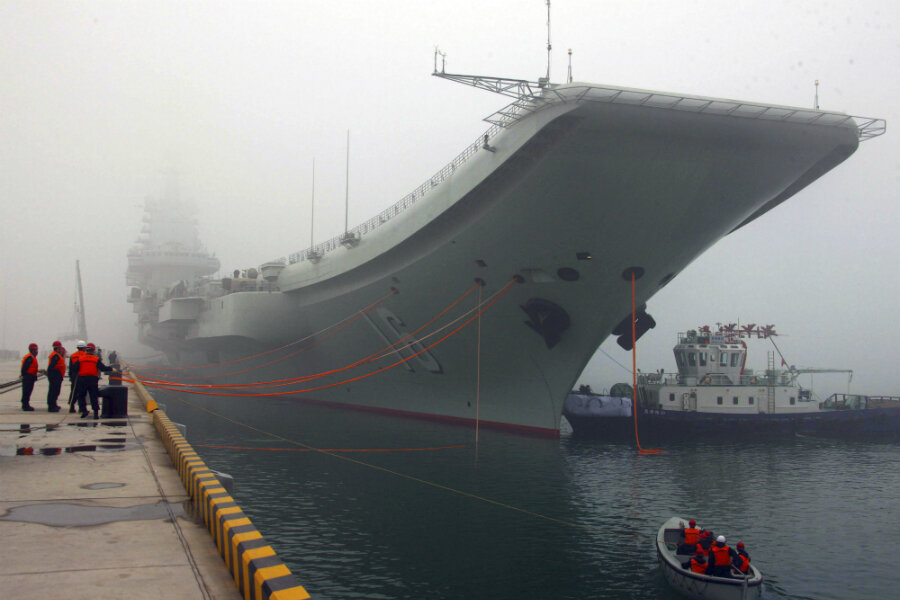Why did China just send an aircraft carrier through the Taiwan Strait?
Loading...
A Chinese naval fleet led by the country’s sole aircraft carrier sailed through the Taiwan Strait on Wednesday, in the latest sign of escalating tensions between China and Taiwan.
The ships did not cross into Taiwanese territorial waters, said Taiwan’s defense ministry, though they did enter its air defense identification zone, causing the ministry to scramble its jets and navy ships to "surveil and control" the passage of the ships, according to Reuters.
"I want to emphasize our government has sufficient capability to protect our national security. It's not necessary to overly panic," said Taiwanese minister for mainland affairs Chang Hsiao-yueh during a news briefing.
"On the other hand, any threats would not benefit cross-Strait ties," she added, according to the newswire.
Tensions between the self-governing island and China, which claims it as part of its territory, could make the United States’ own troubled relationship with Asia’s biggest power even rockier, at a time when the incoming US president, Donald Trump, casts doubt on the "one China" policy bedrock of US-China relations.
Taiwanese President Tsai Ing-wen has appeared emboldened by Mr. Trump’s decision to take a congratulatory phone call from her last month. On Sunday, she met with senior Republican lawmakers in Houston en route to Central America, as Ralph Jennings reported for The Christian Science Monitor:
Beijing has asked the US government to bar [President] Tsai from her scheduled stopovers. Taiwanese presidents normally lay over for a day or two in major cities to see low-level US officials and meet Taiwanese business groups and influential Taiwanese based in the US. US officials normally allow them rest and refueling stops en route to Latin America, since the US is on the fastest flight path.
Transiting Taiwan presidents seldom meet high-level US officials, who are mindful of upsetting their trade, investment, and security relationships with China.
But this month’s stops in the US follow the 12-minute Tsai-Trump call, which surprised Beijing leaders, whose stature as heads of the No. 2 world economy has typically dissuaded US politicians from such contact with Taiwanese counterparts. Prior to the call, the last high-level contact between Taiwan and the US was in the 1970s, when the US dropped formal ties with Taiwan in favor of larger, faster-growing China.
The naval incident also came the same day as the release of a report from China’s cabinet on Asia-Pacific security cooperation that praised China’s regional cooperation and underlined its commitment to "promoting peace and stability in this region."
But the report also reiterated its maritime claims to waters and islands in the South China Sea, as well as Japan-administered territories in the East China Sea, and denounced the US-guided deployment of a missile-defense system in South Korea as seriously damaging to Chinese security interests.
"Looking ahead in 2017, the development of cross-strait relations faces increased levels of uncertainty and the challenge of risk has risen," Ma Xiaoguang, spokesman for the Cabinet's Taiwan Affairs Office, told the Associated Press.
As The Christian Science Monitor’s Michael Holtz noted in December, a string of incidents in the closing weeks of 2016 underscored the anxieties of the coming year:
First came reports that China had installed weapons along a string of disputed islands. Then, a day later, a Chinese naval vessel seized a US underwater drone near the Philippines.
The incident sparked one of the tensest standoffs between Beijing and Washington in more than a decade and ignited a volley of criticism from President-elect Donald Trump. China returned the drone on Dec. 20, but it had signaled its dominance in the South China Sea, a strategically vital area through which about $5 trillion in global trade passes each year.
Whether the drone seizure was a one-off, or a sign of what’s to come from an increasingly assertive Beijing, remains to be seen. But the release of satellite images that show weapons on disputed islands confirms its hardening military grip on the region.
…
“The waters will remain choppy,” says Zhu Feng, executive director of the China Center for Collaborative Studies of the South China Sea at Nanjing University. “The mood on both sides is getting worse.”
This report contains material from the Associated Press and Reuters.








